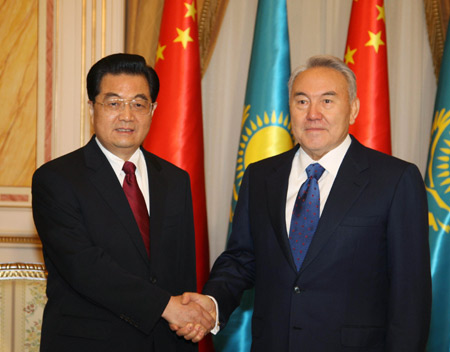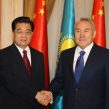
Kazakhstan Looks East: Sino-Kazakh Strategic Partnership Deepens
Publication: Eurasia Daily Monitor Volume: 8 Issue: 128
By:

The strategic partnership signed between Kazakhstan and China on July 4, 2005 has now taken a significant step toward further expansion, based on political, economic, security and cultural ties. President Hu Jintau and his Kazakhstani counterpart Nursultan Nazarbayev agreed to the details of an “all-round” strategic partnership on June 13, which included boosting the bilateral trade volume by 2015 and holding regular meetings at the prime ministerial level (Xinhua, June 13).
Kazakhstani Sinologists anticipated that the bilateral relationship might reach a watershed in 2011 during Kazakhstan’s presidency of the Shanghai Cooperation Organization (SCO). Indeed, both countries’ media noted that President Nazarbayev met his Chinese counterpart arriving at Astana airport for the SCO summit – the only foreign leader to be afforded such treatment ahead of the event. Equally, it was clear that Astana and Beijing had carefully pre-prepared a whole range of measures aimed at strengthening trade and political ties, culminating in the signing of the “Development of an All-Round Strategic Partnership” (Interfax-Kazakhstan, June 14).
Ahead of Hu’s visit to Astana, Assistant Foreign Minister Cheng Guoping told a press briefing in Beijing that the bilateral relationship would be enhanced. “We have witnessed increasing political mutual trust, over $20 billion in trade volume, expanded cooperation in key areas such as energy and security and close coordination under multilateral frameworks between the two countries,” Cheng noted (Xinhua, June 7). Beijing also announced in early June that by July 1, The China-Kazakhstan Horgos International Border Cooperation Center would open, acting as a “transnational market place for citizens from China, Kazakhstan and third countries to negotiate business and trade.” Hu and Nazarbayev initiated such a regional zone under the framework of the SCO. The center covers 3.34 square kilometers in China and 1.85 kilometers in Kazakhstan, and cost more than 880 million Yuan ($136.14 million) (Xinhua, June 1).
During Kazakhstan’s twenty years of independence, it has established diplomatic ties with its powerful neighbor, resolved border issues, signed the “China-Kazakhstan Good-Neighborly Treaty of Friendship,” later forging a strategic partnership and promoting bilateral trade. References to the trade volume reaching $20 billion in 2011 marked China becoming Kazakhstan’s main trading partner – eclipsing Russia (Kazakhstan’s trade with Russia in 2010 reached $13.3 billion). Yet, the latest Sino-Kazakh agreement included setting the target of $40 billion annual trade by 2015; predominantly driven by China’s interest in Kazakh energy resources (www.centralasiaonline.com, June 14). It appears that China intends to markedly outperform any other actor as it further develops commercial and economic links with Kazakhstan.
During Hu’s visit, a $1 billion currency swap was agreed. Kazakhstan will begin supplying nuclear fuel pellets to China. Nazarbayev stated, “There are wide prospects for cooperation in the area of atomic energy. In particular, joint production of nuclear fuel and the construction of atomic electricity stations.” The China Development Bank also extended a $15 billion loan to the Kazakhstani mining company, Kazakhmys, to develop a large copper mine in Aktogay, in eastern Kazakhstan. Indeed, Kazakhstan is now China’s main energy supplier, with the Kazakhstan-China oil pipeline delivering 11 million tons of oil to China in 2010; this figure is set to grow in the future as work continues to complete phase two of this project as well the second stage of the gas pipeline (NTDTV, June 15; www.centralasianewswire, June 13).
In this context, the new strategic partnership agreement, according to Hu, is based around several proposals advanced by Beijing. This involves becoming “sincere and trustworthy partners” in political cooperation, as the basis of the partnership. On Beijing’s part this will involve safeguarding the “sovereignty and security” of Kazakhstan, and promoting its development. Both countries will forge a mutually beneficial “win-win” trade and economic partnership. Hu said that energy cooperation would be extended to clean and “new” energy projects. Beijing will also support Kazakhstan’s efforts to join the world Trade Organization (WTO). Cultural ties will deepen, and as part of that process the quotas of students from Kazakhstan studying in China will increase. Partnership will be pursued in science and technology; exchanges between scientific research institutes, high-technology enterprises, and aviation and space projects. Security cooperation would center on bilaterally combating the “three forces” of extremism, separatism and terrorism, while Beijing is willing to coordinate its position with Astana on regional and international issues (Xinhua, June 13).
The preamble in the “All-Round Strategic Partnership” text states: “This partnership is not an alliance. Nor is it targeted at any third nation. Regardless of how the international and regional situations change, the development of an all-round strategic partnership between China and Kazakhstan is a diplomatic priority for both countries.” According to the text of the partnership agreement, Astana fully supports the “one China” policy and disavows any future action to “establish or engage in official ties with Taiwan.” Beijing supports Kazakhstan’s sovereignty and its own path of development: “The two sides reiterate our support for the other side’s effort to defend its national sovereignty, security, and territorial integrity. We will not permit the establishment on our soil of organizations and groups that seek to damage the other side’s sovereignty, security, and territorial integrity, nor will we permit their activities.” The agreement also promotes China’s access to western markets through Central Asia and the further development of transportation and infrastructure projects: “China actively supports the construction of the Astana-Alamutu Railway, the international transportation corridor linking Western Europe with western China, and the project linking the Jinghe-Yining-Horgos Railway in China with the Reteken-Horgos Railway in Kazakhstan” (Full Text of China-Kazakhstan Joint Statement on the Development of All-Round Strategic Partnership, Xinhua, June 13).
Expanding the scope of the existing strategic partnership comes at a time when China has emerged as Kazakhstan’s main trading partner. While this development will undoubtedly have political implications, as well as potentially changing regional dynamics, the ambitious target of doubling bilateral trade within four years suggests that Beijing’s interest and influence in Central Asia is set to grow. It has occurred as the center of the global economy shifts from the Euro-Atlantic area toward the Asia-Pacific Region. Moreover, while it does not represent any move to form an alliance, the references in the text to Beijing’s interest in protecting Kazakhstan’s sovereignty imply political clout riding on the wave of China’s economic power. As these implications become clearer, Moscow will have to adjust to its new role in the second violin section of the Eurasian orchestra.




